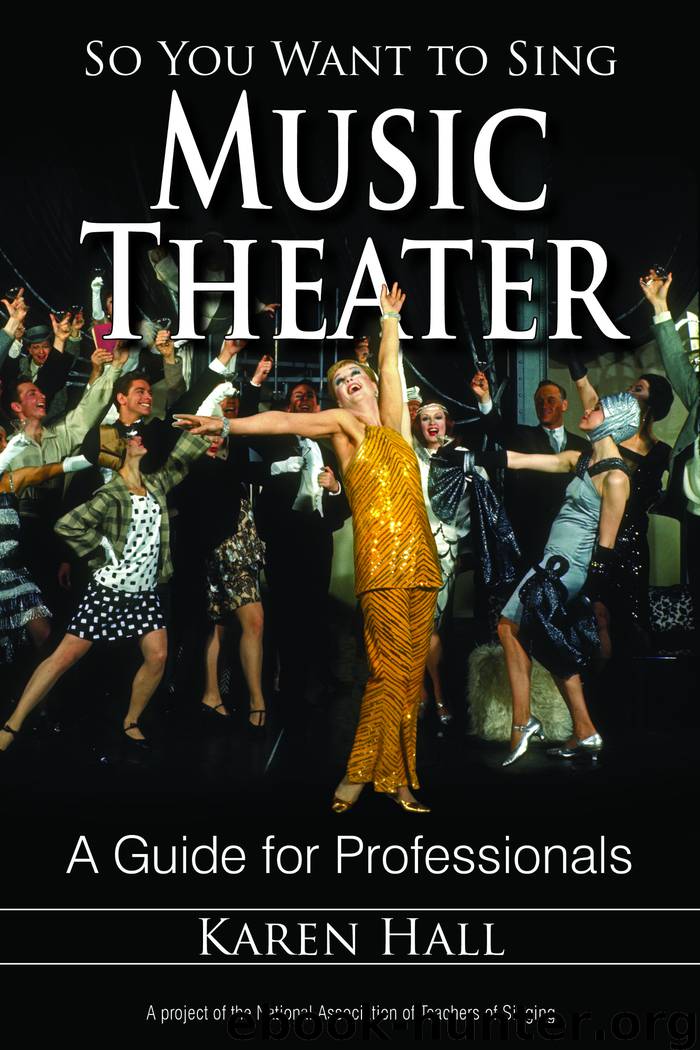So You Want to Sing Music Theater by Karen Hall

Author:Karen Hall
Language: eng
Format: epub
Tags: undefined
Publisher: Rowman & Littlefield Publishers
Published: 2012-06-22T16:00:00+00:00
Tone Quality Adjustment/Resonance
By changing where your voice resonates, you can achieve the brighter tone quality color often favored in music theater singing. The resonance adjustment can be used in conjunction with vocal fold function and adjustments. There are two actual resonators for the voice: the mouth/nasal cavity and the throat or pharyngeal cavity. The throat space resonance creates a darker tone quality color, and the mouth space resonance creates a brighter tonal quality singing color.
The contemporary music theater sound, which emphasizes the enunciation of the text rather than the beauty of the voice, results in singing that uses less resonance than classical production. Therefore, when a show is revived, the male and female roles are most often sung with a more contemporary sound. This change in singing styles also requires accompanying tone quality adjustments.
Tone quality is adjusted by changing the shape (mouth position) and/or color (resonance position) of a vowel. Changing the shape of the vowel, in turn, changes the color of a sung tone to a more speech-like sound and alters the resonance qualities and space. These vowel adjustments are employed to clarify the text and ensure that the enunciation of the text predominates. The articulators (lips, tongue, jaw) shape differently for each vowel; it is this change in shape that is perceived by the ear as the brighter, more speech-like sound favored in music theater singing. Altering the shape of vowels to a more “forward” (but not nasal) placement and changing the shape of the mouth horizontally in a smile-like shape are two of the best ways to accomplish speech-like tone quality adjustment, as opposed to the stretched pharyngeal shape used in classical singing (Hall, 2006).
Because singing in music theater is electronically amplified, resonance requirements are not the same as in classical singing. Often the text or style in a music theater song calls for many different types of resonance, so consistent resonance throughout the voice is not necessary in music theater singing.
Resonance and vocal color exercises are located on the NATS website, http://www.nats.org. Click on the “resources” tab and follow the instructions.
Download
This site does not store any files on its server. We only index and link to content provided by other sites. Please contact the content providers to delete copyright contents if any and email us, we'll remove relevant links or contents immediately.
| Appreciation | Blank Sheet Music |
| Composition | Conducting |
| Exercises | Instruction & Study |
| Lyrics | MIDI, Mixers, etc |
| Philosophy & Social Aspects | Songwriting |
| Techniques | Theory |
| Vocal |
The Goal (Off-Campus #4) by Elle Kennedy(12547)
Kathy Andrews Collection by Kathy Andrews(10607)
Diary of a Player by Brad Paisley(6887)
What Does This Button Do? by Bruce Dickinson(5563)
Assassin’s Fate by Robin Hobb(5284)
Big Little Lies by Liane Moriarty(4918)
Pale Blue Dot by Carl Sagan(4051)
Sticky Fingers by Joe Hagan(3474)
The Heroin Diaries by Nikki Sixx(2957)
The Death of the Heart by Elizabeth Bowen(2937)
Beneath These Shadows by Meghan March(2747)
The Help by Kathryn Stockett(2724)
Confessions of a Video Vixen by Karrine Steffans(2701)
How Music Works by David Byrne(2567)
Jam by Jam (epub)(2514)
Harry Potter 4 - Harry Potter and The Goblet of Fire by J.K.Rowling(2442)
Strange Fascination: David Bowie: The Definitive Story by David Buckley(2384)
Petty: The Biography by Warren Zanes(2255)
Darker Than the Deepest Sea by Trevor Dann(2231)
